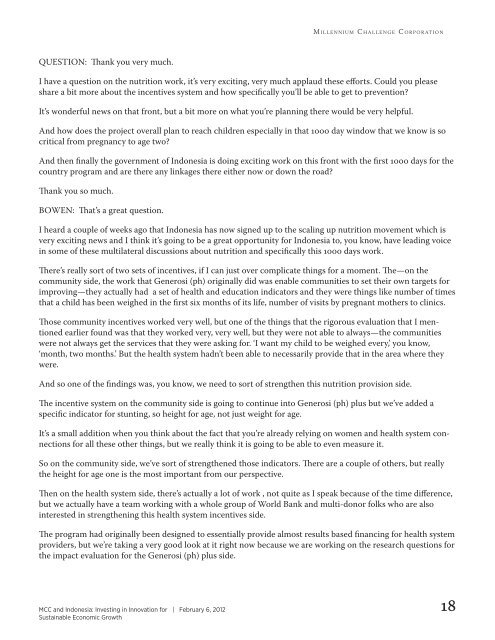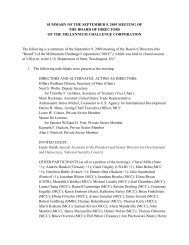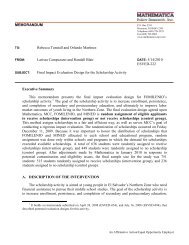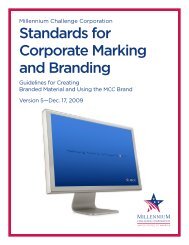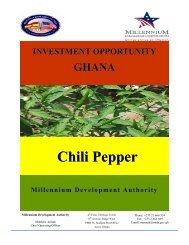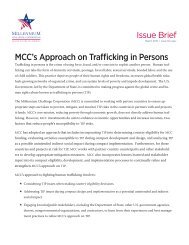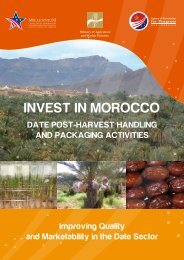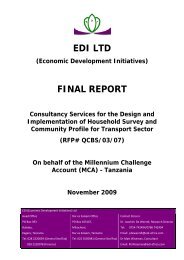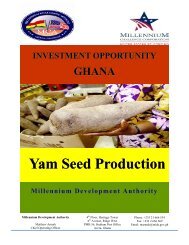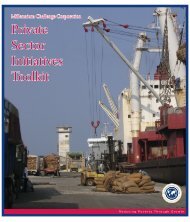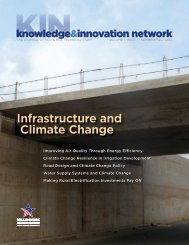Transcript - Millennium Challenge Corporation
Transcript - Millennium Challenge Corporation
Transcript - Millennium Challenge Corporation
Create successful ePaper yourself
Turn your PDF publications into a flip-book with our unique Google optimized e-Paper software.
QUESTION: Thank you very much.<br />
I have a question on the nutrition work, it’s very exciting, very much applaud these efforts. Could you please<br />
share a bit more about the incentives system and how specifically you’ll be able to get to prevention?<br />
It’s wonderful news on that front, but a bit more on what you’re planning there would be very helpful.<br />
And how does the project overall plan to reach children especially in that 1000 day window that we know is so<br />
critical from pregnancy to age two?<br />
And then finally the government of Indonesia is doing exciting work on this front with the first 1000 days for the<br />
country program and are there any linkages there either now or down the road?<br />
Thank you so much.<br />
BOWEN: That’s a great question.<br />
I heard a couple of weeks ago that Indonesia has now signed up to the scaling up nutrition movement which is<br />
very exciting news and I think it’s going to be a great opportunity for Indonesia to, you know, have leading voice<br />
in some of these multilateral discussions about nutrition and specifically this 1000 days work.<br />
There’s really sort of two sets of incentives, if I can just over complicate things for a moment. The—on the<br />
community side, the work that Generosi (ph) originally did was enable communities to set their own targets for<br />
improving—they actually had a set of health and education indicators and they were things like number of times<br />
that a child has been weighed in the first six months of its life, number of visits by pregnant mothers to clinics.<br />
Those community incentives worked very well, but one of the things that the rigorous evaluation that I mentioned<br />
earlier found was that they worked very, very well, but they were not able to always—the communities<br />
were not always get the services that they were asking for. ‘I want my child to be weighed every,’ you know,<br />
‘month, two months.’ But the health system hadn’t been able to necessarily provide that in the area where they<br />
were.<br />
And so one of the findings was, you know, we need to sort of strengthen this nutrition provision side.<br />
The incentive system on the community side is going to continue into Generosi (ph) plus but we’ve added a<br />
specific indicator for stunting, so height for age, not just weight for age.<br />
It’s a small addition when you think about the fact that you’re already relying on women and health system connections<br />
for all these other things, but we really think it is going to be able to even measure it.<br />
So on the community side, we’ve sort of strengthened those indicators. There are a couple of others, but really<br />
the height for age one is the most important from our perspective.<br />
Then on the health system side, there’s actually a lot of work , not quite as I speak because of the time difference,<br />
but we actually have a team working with a whole group of World Bank and multi-donor folks who are also<br />
interested in strengthening this health system incentives side.<br />
The program had originally been designed to essentially provide almost results based financing for health system<br />
providers, but we’re taking a very good look at it right now because we are working on the research questions for<br />
the impact evaluation for the Generosi (ph) plus side.<br />
MCC and Indonesia: Investing in Innovation for | February 6, 2012<br />
Sustainable Economic Growth<br />
18


